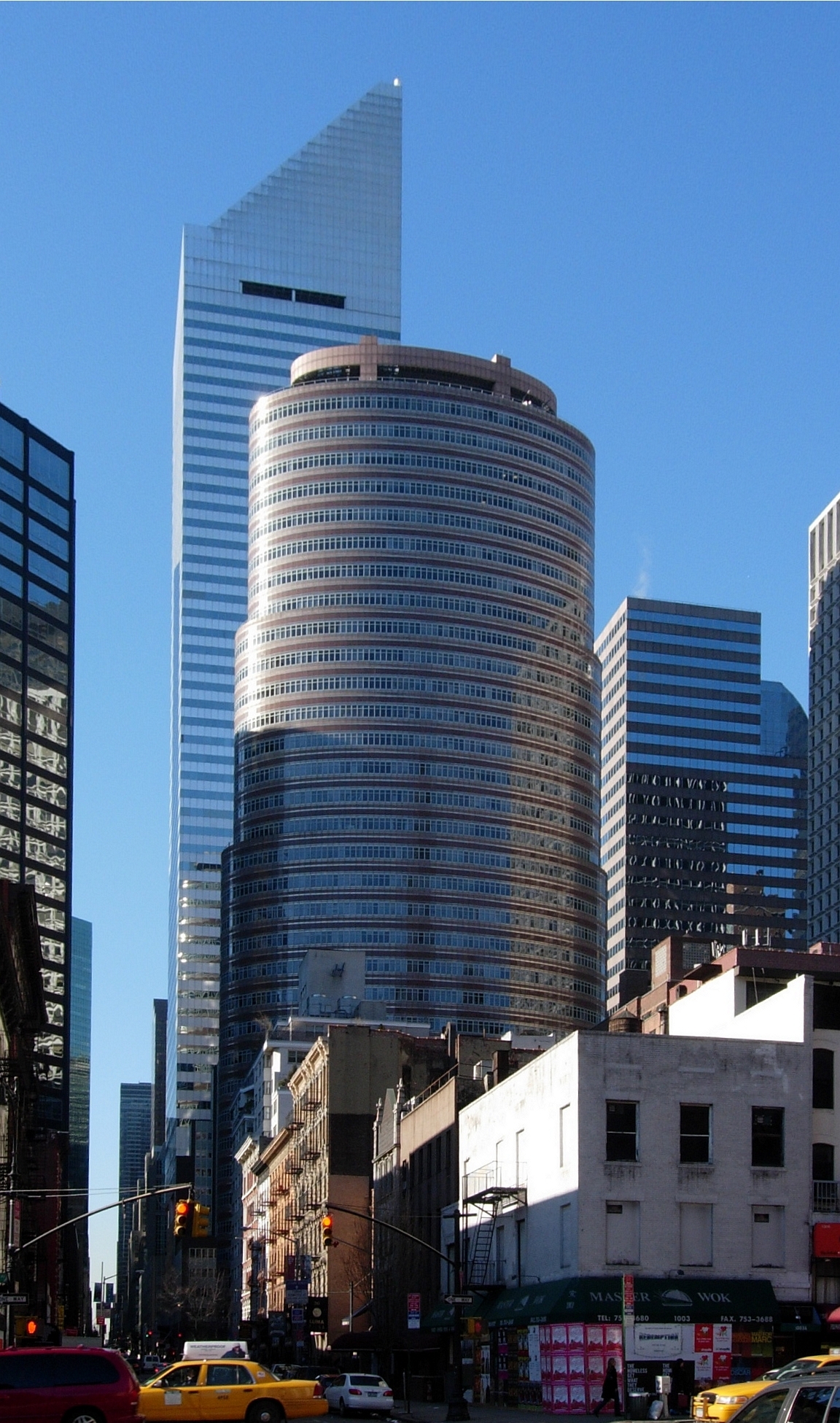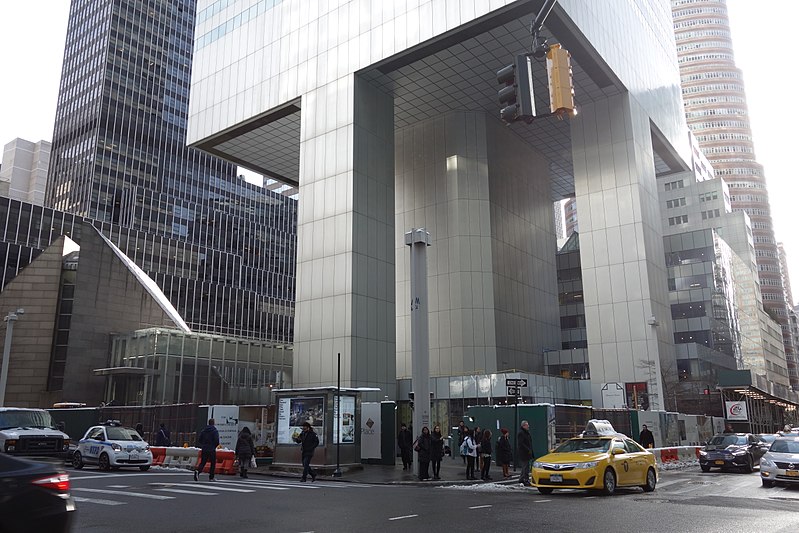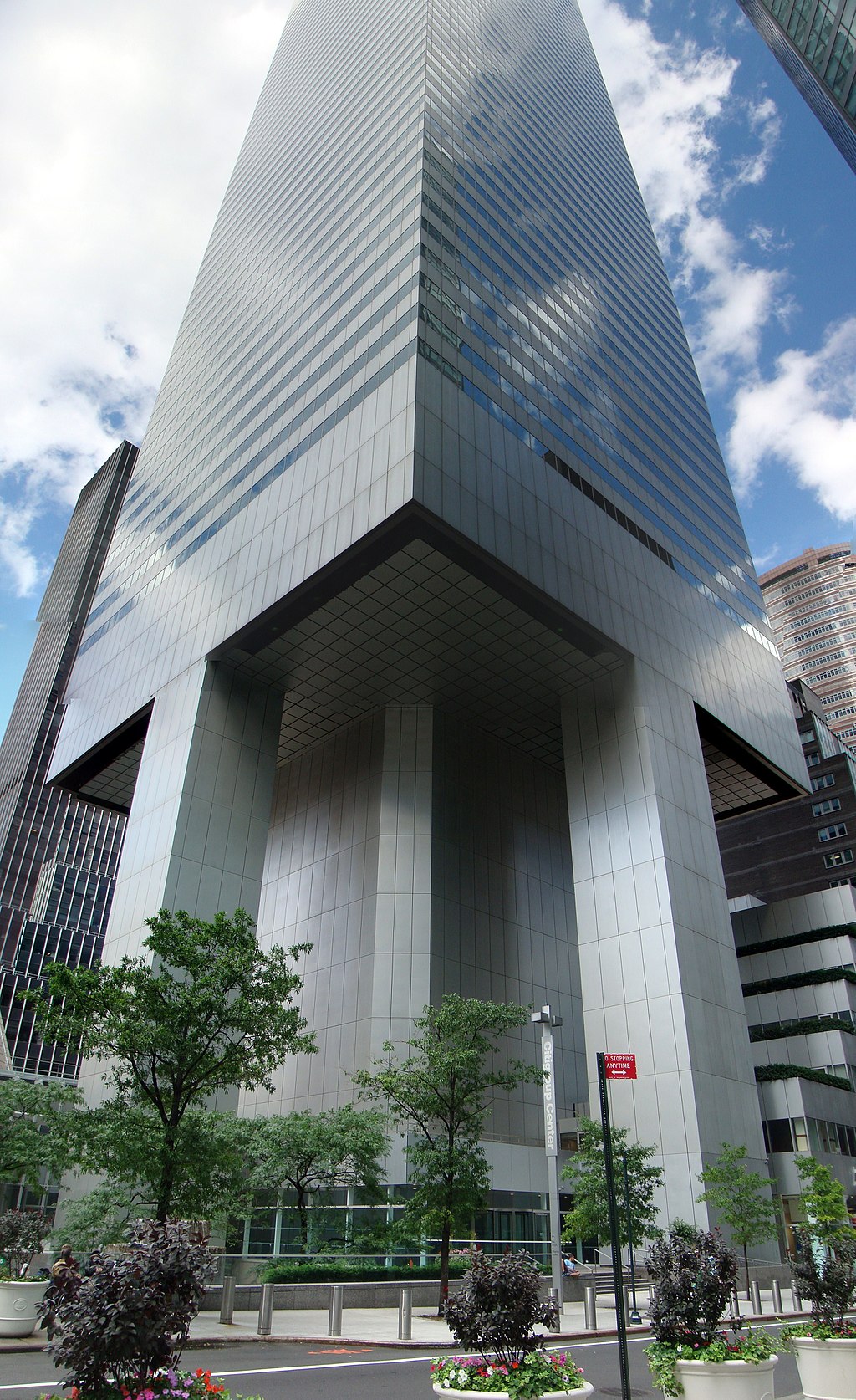Citigroup Center
 The Citigroup Center's angled roof is seen behind The Lipstick Building, which was designed by John Burgee Architects with Philip Johnson.
The Citigroup Center's angled roof is seen behind The Lipstick Building, which was designed by John Burgee Architects with Philip Johnson.
Contents |
[edit] Introduction
The Citigroup Center (originally referred to as Citicorp Center but now known as 601 Lexington Avenue) is one of New York City’s many skyscrapers. Its angled top gives it an iconic appearance that helps it stand out from other buildings in that part of the Manhattan skyline, but its unusual base and invisible engineering are other characteristics that distinguish it from other buildings.
[edit] The church issue
What is not visible about this building is a series of engineering errors that could have been one of the biggest disasters in modern architectural history - all because of a church.
In 1970, architect Hugh Stubbins came up with plans for the 59-story glass and metal clad tower for First National City Bank (later known as Citigroup). There was one problem with the site that had been selected - an existing church had to be accommodated in the plans in order for the purchase of the site to be approved. The decision was made to demolish the old church and rebuild it in the same location in a manner that would comply with the wishes of the congregation.
This view shows the entrance to the Lexington Avenue subway complex in East Midtown Manhattan. St Peter's Lutheran Church is the angle topped structure pictured in the left of the image.
The structural engineer William LeMessurier created a solution - four stilt-like columns that would support the massive structure at the centre of each side rather than at its corners. A fifth supporting column at the central core of the building was located at the elevator shaft.
Meanwhile, the newly built, freestanding St Peter's Lutheran Church would remain in its original location but tucked under the cantilevered corner of the new skyscraper that would be built above and around it. At no point would columns or supports for the skyscraper be permitted to go through the church.
[edit] The stilt solution
At roughly nine stories high, the 'stilts' created a possible issue with stability for the high rise building. To address this problem, LeMessurier designed a chevron shaped exoskeleton system of giant braces that would redistribute the building’s weight securely down to the stilts.
While the braces helped to redistribute the weight, they would also make the building too light for its height, thus it would sway during extreme weather conditions accompanied by high winds. This is not an unusual occurrence for New York City, which can experience hurricanes in the autumn and nor'easters in the winter.
To correct this issue, an electrically operated tuned mass damper (weighing 350 metric tonnes) was installed at the top of the building. This would act as a counterbalance against strong winds and keep the building from swaying.
[edit] Potential for disaster
The building was completed in 1976 and opened in 1977, but in 1978, a new (but not really new) problem was uncovered.
A civil engineering student at Princeton University had studied the building for her undergraduate thesis and realised calculations for its wind load only took into account perpendicular winds (north, south, east, west) but not quartering winds (northeast, northwest, southeast, southwest). Both types of wind load considerations were mandatory according to New York City’s building codes, and recalculations were required.
This data revealed a major design flaw with the joints of the chevron bracing - they would struggle to support the building from a strong quartering wind. This problem was made even worse due to an issue with the joints. The builder had switched from welded joints to bolted joints as a cost cutting measure. The decision was approved by LeMessurier’s firm but without his direct knowledge.
The cost cutting measure meant that hurricane force quartering winds above 75 miles per hour could shear bolts and compromise joints that had not been welded. Under those conditions, the chevrons would struggle to hold the building up.
The situation would be further compromised by a power outage - something that often happens during hurricanes. A blackout would render the electrical mass damper inoperable and the building would sway dramatically. The inadequate bolts would be subject to even greater stress.
In one additional calculation error, LeMessurier discovered that New York City’s truss safety factor of 1:1 had been used by his firm instead of the 1:2 column safety factor. Based on this combination of errors, the decision was made to correct the situation immediately - but in secret.
[edit] Structural remediation
Only key personnel and first responders were made aware of the repairs. The undertaking was given the code name Project SERENE (short for Special Engineering Review of Events Nobody Envisioned).
For three months, the general public and those who worked in the building did not know about the remediation activities. Welders were brought in from across the country to fix steel plates over all of the bolted joints, but they could only work in the evenings. Meanwhile, weather experts kept a close watch on the upcoming hurricane season.
The story was kept quiet until 1995, when a magazine article uncovered how the public had been unaware of the dangerous situation. It also raised a serious issue over professional ethics and the practice of architecture.
[edit] Citigroup no more
In 2001, Citigroup moved out of the building and sold much of its remaining interest to Boston Properties. The building was then renamed 601 Lexington Avenue.
Additional structural remediation work was performed on the building in 2002 in response to the attacks of 9/11. Blast resistant shields and additional steel bracing were added to one of the columns as protection against possible terrorist activity.
[edit] Related articles on Designing Buildings Wiki
- American architecture and construction.
- Empire State Building.
- Ethics and the engineer.
- Ethics in construction.
- Exoskeleton.
- Flatiron Building.
- Heroic architecture.
- High-rise building.
- Managing and Responding to Disaster.
- Skyscraper.
- Truss.
- Using springs in construction to prevent disaster.
[edit] External resources
- AIA Trust, LeMessurier Stands Tall: A Case Study in Professional Ethics by Michael J Vardaro, Esq.
- National Academy of Engineering, William LeMessurier-The Fifty-Nine-Story Crisis: A Lesson in Professional Behavior (video of LeMessurier lecture from 1995).
- New Yorker, The Fifty-Nine-Story Crisis by Joseph Morgenstern.
Featured articles and news
RTPI leader to become new CIOB Chief Executive Officer
Dr Victoria Hills MRTPI, FICE to take over after Caroline Gumble’s departure.
Social and affordable housing, a long term plan for delivery
The “Delivering a Decade of Renewal for Social and Affordable Housing” strategy sets out future path.
A change to adoptive architecture
Effects of global weather warming on architectural detailing, material choice and human interaction.
The proposed publicly owned and backed subsidiary of Homes England, to facilitate new homes.
How big is the problem and what can we do to mitigate the effects?
Overheating guidance and tools for building designers
A number of cool guides to help with the heat.
The UK's Modern Industrial Strategy: A 10 year plan
Previous consultation criticism, current key elements and general support with some persisting reservations.
Building Safety Regulator reforms
New roles, new staff and a new fast track service pave the way for a single construction regulator.
Architectural Technologist CPDs and Communications
CIAT CPD… and how you can do it!
Cooling centres and cool spaces
Managing extreme heat in cities by directing the public to places for heat stress relief and water sources.
Winter gardens: A brief history and warm variations
Extending the season with glass in different forms and terms.
Restoring Great Yarmouth's Winter Gardens
Transforming one of the least sustainable constructions imaginable.
Construction Skills Mission Board launch sector drive
Newly formed government and industry collaboration set strategy for recruiting an additional 100,000 construction workers a year.
New Architects Code comes into effect in September 2025
ARB Architects Code of Conduct and Practice available with ongoing consultation regarding guidance.
Welsh Skills Body (Medr) launches ambitious plan
The new skills body brings together funding and regulation of tertiary education and research for the devolved nation.
Paul Gandy FCIOB announced as next CIOB President
Former Tilbury Douglas CEO takes helm.
UK Infrastructure: A 10 Year Strategy. In brief with reactions
With the National Infrastructure and Service Transformation Authority (NISTA).

























